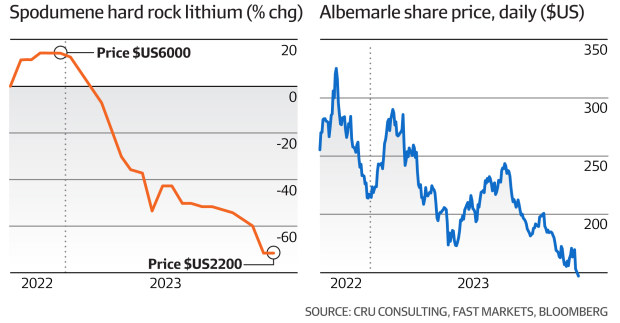Battery metal prices collapse on supply glut, cool Chinese EV demand

Prices for key battery metals required for the clean energy transition – such as lithium and nickel – have collapsed since the start of the year amid a supply glut and Chinese consumers reducing demand for electric vehicles.
The price of lithium, Australia’s sixth most valuable mining export, has fallen 30 per cent in a fortnight and has plunged 63 per cent since the start of the year.
The collapse in price prompted Rio Tinto to hint earlier this week that the three-year boom in lithium prices could be coming to an end. But the mining giant is still betting predicted supply shortages will ensure strong “market fundamentals” for the battery mineral longer term.

The price of lithium has fallen 30 per cent in a fortnight. New York Times
Australia’s billionaire mining magnates appear to agree. Despite the collapse in price, The richest Australian, Gina Rinehart, and billionaire lithium mining pioneer, Chris Ellison, are buying up the country’s battery-metal assets.
But jockeying for lithium projects blew up spectacularly on Monday when New York-listed Albemarle abandoned its $6.6 billion bid for Liontown Resources after Ms Rinehart bought up a 19.9 per cent stake in the lithium hopeful. Liontown is now licking its wounds as it scrambled to secure a $1.18 billion funding package on Thursday night and suffered a 32 per cent collapse in its share price on Friday.
Lithium prices have soared to record levels in the past three years as carbon-conscious government stimulus underwrote strong demand for the lithium-ion batteries that power electric vehicles. Australia mines about 53 per cent of the world’s supply of lithium, virtually all of which is sold to China.
The surge in demand came as lithium miners struggled to recover output rates that were curtailed during the severe lithium bear market that reigned between mid-2018 and mid-2020.

“We began the year with the prices hitting dizzying, never-before-seen, highs,” said Barrenjoey analyst Daniel Morgan.
Lithium-rich spodumene fetched $US6000 per tonne at the beginning of the year, says Cru Group, a London-based mining consultancy.
By Wednesday, the price had collapsed to $US2200 per tonne. A fortnight ago, Benchmark Minerals Intelligence reported spodumene fetched $3200 per tonne on October 5, which amounts to a 30 per cent decline in two weeks.
“The high prices were due to supply anxiety,” Mr Morgan said. “Last year EV sales were very strong and there was not enough lithium to convert into batteries. That supply and demand mismatch has eased throughout the entire year and brought down the price.”
Rio Tinto expects the trend to persist, telling the market on Tuesday that prices will be dampened by slowing electric vehicle sales growth in China and lower immediate demand for raw materials because refiners and manufacturers bought more of the commodity than needed in previous months.
Martin Jackson, head of battery raw materials at CRU Group, said EV sales will increase 37 per cent year on year, which is “certainly not weak growth”, but the existing inventory glut shows demand for lithium will not be as strong.
“Refiners in China are still reporting high inventories of both product and raw materials even though they are actively trying to draw down working stocks,” he said.
Rio told the ASX on Tuesday that strong lithium mine output could also weigh on prices: “Supply from non-traditional regions (Africa) is coming to market, incentivised by two years of elevated prices.”
Mr Jackson expects prices to remain dampened by the additional supplies and inventory draw – using stockpiled raw materials rather than buying new supply. The price in the December quarter will settle about $2200 to $2400 per tonne, he said.
UBS downgraded its spodumene forecast last week through June next year to $US2500 per tonne because of wariness about next year’s demand for electric vehicles.
“While EV sales (predominantly out of China) remain robust despite growing macro pressures, we are wary on the 2024 outlook,” said Levi Spry, a UBS mining analyst.
“Our sentiment is shared by stakeholders along the EV value chain, and there remains an aversion to restock with a high degree of uncertainty on the near-term outlook.”
S&P also downgraded its projections for “green” metals such as copper and nickel this week – crucial for batteries – and upgraded its price outlook for thermal coal, coking coal, and iron ore. According to the London Metals Exchange, nickel is down 40 per cent, while copper is down 12 per cent.
Introducing your Newsfeed
Follow the topics, people and companies that matter to you.
Find out moreRead More
Latest In Mining
Fetching latest articles